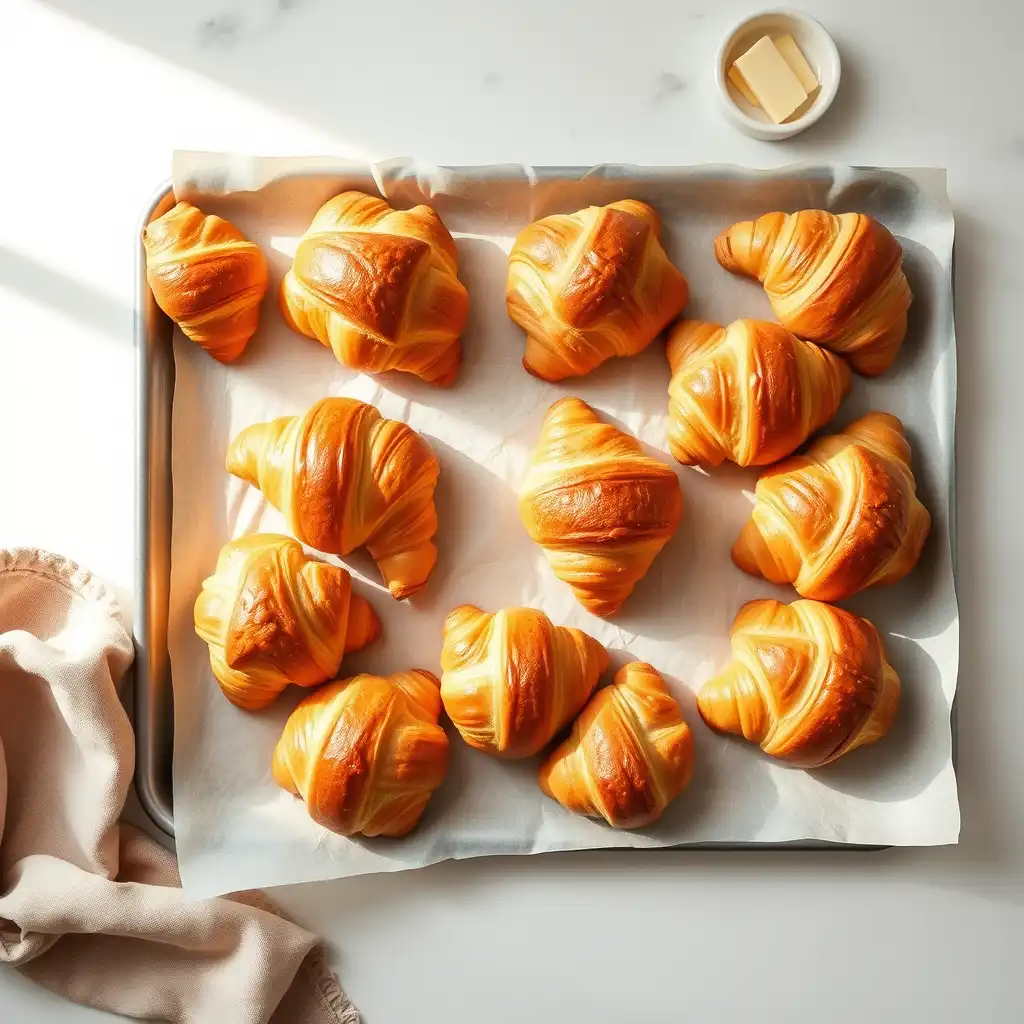It was 3:14 a.m. in a tiny Parisian kitchen when I ruined my first batch of croissants. Burnt, flat, and weirdly chewy. I wanted to scream. But there was something poetic about the silence in that moment—me, my dough, and the relentless hum of a tiny fridge that probably hadn’t been defrosted since the ’80s. Fast forward a decade, and I still think about that first bite of a croissant done right—shatteringly crisp on the outside, honeycomb-soft on the inside, buttery enough to make you question your life choices.
This recipe is for that kind of croissant.
This is not your average “hey-let’s-make-croissants-today” situation. This is about precision, temperature, timing, and butter—so much butter. But when done right? It’s culinary architecture. The kind that flakes all over your lap and makes your morning coffee taste 100x better.
Ingredients & Substitutions for Perfect Homemade French Croissants
Flour
Start with strong bread flour (11-13% protein). You want gluten, and lots of it. It’s the structural rebar of your flaky skyscraper. Don’t reach for all-purpose flour unless you’re cool with heartbreak.
Substitution: If you must, mix 75% all-purpose with 25% vital wheat gluten. It’s not ideal, but hey—life ain’t perfect.
Yeast
Use instant yeast for reliability and speed. If you’re a romantic, active dry yeast works too—just bloom it in lukewarm water first like it’s 1995.
Avoid fresh yeast unless you’ve worked with it before. It’s temperamental. Gorgeous flavor though, if you can get it right.
Sugar
Just enough to feed the yeast and help with browning—don’t overdo it. About 50g per batch is perfect.
Salt
Uniodized fine sea salt. Always. You want the salt to melt into the dough, not sit there like little flavor bombs waiting to ruin your bite.
Milk
Whole milk. No debates. The fat adds richness, and the lactose helps with browning. If you’re dairy-free, use oat milk—but your results won’t be quite the same.
Butter
The heart of this operation. Use European-style butter (82-85% fat) like Président, Plugrá, or Kerrygold. Why? Lower water content means flakier layers.
Substitution: Don’t. Please. Just don’t. Margarine? Absolutely not. You need butter that folds like velvet and tastes like Paris.
Egg
One egg, for egg wash. That’s it. Whisked with a touch of milk for that glossy café window shine.

Step-by-Step Instructions for Perfect Homemade French Croissants
Step 1: Make the détrempe (basic dough)
Mix flour, sugar, salt, yeast, and milk. Knead it until it’s smooth—like, “sleeping puppy belly” smooth. About 8 minutes by stand mixer, 12 by hand.
Wrap and chill for at least 6 hours, preferably overnight. You want the dough relaxed and cold. Cold dough = good lamination.
Step 2: Make the beurrage (butter block)
Form your butter into a 6-inch square between two sheets of parchment. Smack it gently with a rolling pin—imagine you’re calming it down, not punishing it.
Chill the butter square until it’s firm but pliable. Around 60°F (15°C) is the goldilocks zone. Not too soft. Not too brittle.
Step 3: Laminate
Roll the dough into a 10-inch square. Place your butter in the center like a diamond and fold the corners over it like an envelope.
Now roll it out gently to a long rectangle and do a single fold (book fold or letter fold—up to you). Wrap, chill 30 minutes. Repeat twice.
That’s three total folds. Don’t go rogue and add more. You’ll squish the layers into oblivion.
Step 4: Shape
Roll your laminated dough into a rectangle, about ¼ inch thick. Cut long triangles—base about 3 inches, height about 8. Stretch the tip gently, roll tightly.
Place on a tray, tip side down, and proof at 78°F (26°C) for about 2–3 hours until jiggly, puffy, and slightly doubled.
Don’t proof too hot. You’ll melt the butter. Don’t proof too cold. You’ll get dense sadness in croissant form.
Step 5: Bake
Preheat your oven to 400°F (200°C). Brush the croissants with egg wash. Bake for 18–22 minutes until golden and proud.
Rotate the tray halfway through baking. Croissants are drama queens. They demand even lighting.
Let cool at least 10 minutes before eating. Burning your mouth is not a badge of honor.
Cooking Techniques & Science
Lamination
Lamination is folding layers of butter and dough repeatedly to create hundreds of paper-thin strata. When baked, the water in the butter steams, lifting the dough into flaky layers.
That’s why butter temperature is everything. Too soft? It oozes out. Too hard? It tears the dough. You want them to marry, not fight.
Gluten development
Long, cold fermentation develops flavor and gives the gluten time to relax. A relaxed dough rolls out smoother and rises more evenly. Like a well-rested chef, it performs better.
Proofing
Proper proofing is key. If underproofed, croissants won’t rise in the oven. If overproofed, they collapse. You’re looking for the “wobble test”—gently shake the tray. They should jiggle like a shy jellyfish.
Serving & Pairing Suggestions
Serve warm. Please. Cold croissants are like flat champagne—sad and offensive.
Pair with butter and jam if you’re a purist. Or go bold with whipped goat cheese and roasted grapes. Seriously.
Want savory? Fill before rolling with ham and Gruyère, then bake as usual. Or slice post-bake and stuff with soft scrambled eggs, chives, and smoked salmon. You’re welcome.
Drink? Champagne at brunch. Flat whites anytime. Fresh orange juice for the overachievers.
Presentation-wise, dust with powdered sugar, or leave them naked and proud. Just don’t crowd the plate. Let the layers speak.

Conclusion
Croissants are not easy. And that’s the point. They’re a ritual. A test of your patience and precision. They don’t care how much experience you have—they only care how well you can keep your cool at 4:30 a.m. when the butter starts misbehaving.
But the reward? That one bite where the layers shatter, the center melts, and the butter clings to the roof of your mouth like a good memory. That’s the magic.
Final tip? Trust the fridge. Chill everything more than you think. Chill yourself too, while you’re at it.
Oh, and clean your counter. Flour gets everywhere.
FAQs
How long can I keep homemade croissants?
Once baked, croissants are best eaten the same day. But you can store them in an airtight container for up to 2 days, then reheat at 300°F for 8 minutes. Freeze baked croissants for up to a month—thaw, then warm in the oven.
Can I freeze the unbaked croissants?
Absolutely. After shaping, freeze them on a tray, then store in a freezer bag. When ready, thaw overnight in the fridge and proof before baking. You’ll need to add about an hour to your normal proof time.
Why are my croissants leaking butter in the oven?
Butter leakage usually means your butter was too soft during lamination, or your proofing environment was too warm. Next time, keep everything colder and avoid over-proofing. Also, make sure you seal the dough well when rolling.
Can I make them with whole wheat flour?
Technically yes, but expect denser results. Whole wheat absorbs more liquid and produces a tougher crumb. Try substituting 20–30% of the flour with whole wheat if you’re aiming for a “healthier” twist.
How do I get that perfect honeycomb structure inside?
It’s all about temperature control and proper folding. Don’t rush the chilling steps. Roll evenly. Use high-fat butter. And don’t squish the dough when shaping—gentle hands get the best crumbs.

Olivia P. is a seasoned food blogger at Tastywink, sharing delicious, easy-to-follow recipes inspired by him passion for home cooking. With years of culinary blogging experience, he brings flavor, creativity, and a personal touch to every dish.
